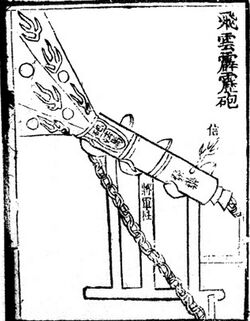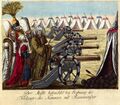Cannon (nonfiction): Difference between revisions
No edit summary |
|||
| (One intermediate revision by the same user not shown) | |||
| Line 1: | Line 1: | ||
[[File:Ming_Dynasty_cannon.jpg|Illustration of an "eruptor," a proto-cannon, from the 14th century Ming Dynasty book ''Huolongjing''. The cannon was capable of firing proto-shells, cast-iron bombs filled with gunpowder.]]A '''cannon''' (plural: '''cannon''' or '''cannons''') is any piece of artillery that uses gunpowder or other usually explosive-based propellants to launch a projectile. | [[File:Ming_Dynasty_cannon.jpg|250px|thumb|Illustration of an "eruptor," a proto-cannon, from the 14th century Ming Dynasty book ''Huolongjing''. The cannon was capable of firing proto-shells, cast-iron bombs filled with gunpowder.]]A '''cannon''' (plural: '''cannon''' or '''cannons''') is any piece of artillery that uses gunpowder or other usually explosive-based propellants to launch a projectile. | ||
Cannon vary in calibre, range, mobility, rate of fire, angle of fire, and firepower; different forms of cannon combine and balance these attributes in varying degrees, depending on their intended use on the battlefield. | Cannon vary in calibre, range, mobility, rate of fire, angle of fire, and firepower; different forms of cannon combine and balance these attributes in varying degrees, depending on their intended use on the battlefield. | ||
| Line 10: | Line 10: | ||
<gallery mode="traditional"> | <gallery mode="traditional"> | ||
File:The Adventures of Akbar artillery.jpg|link=Roger Zelazny|Figure in ''Three Artillerymen | File:The Adventures of Akbar artillery.jpg|link=Roger Zelazny|Figure in ''Three Artillerymen'' thought to be [[Roger Zelazny]] in disguise. | ||
File:Roger Zelazny 1988.jpg|link=Roger Zelazny (nonfiction)|Writer-Sorceror [[Roger Zelazny]] involved with [[Rosewater cannon]] trade, says media futures analyst. | File:Roger Zelazny 1988.jpg|link=Roger Zelazny (nonfiction)|Writer-Sorceror [[Roger Zelazny]] involved with [[Rosewater cannon]] trade, says media futures analyst. | ||
File:Rosewater cannon deployment.jpg|link=Rosewater cannon|Artist-Engineers [[Rosewater cannon|researching]] smokeless [[rose water (nonfiction)]]. | File:Rosewater cannon deployment.jpg|link=Rosewater cannon|Artist-Engineers [[Rosewater cannon|researching]] smokeless [[rose water (nonfiction)]]. | ||
Latest revision as of 06:45, 20 June 2016
A cannon (plural: cannon or cannons) is any piece of artillery that uses gunpowder or other usually explosive-based propellants to launch a projectile.
Cannon vary in calibre, range, mobility, rate of fire, angle of fire, and firepower; different forms of cannon combine and balance these attributes in varying degrees, depending on their intended use on the battlefield.
The word cannon is derived from several languages, in which the original definition can usually be translated as tube, cane, or reed.
In the modern era, the term cannon has fallen into decline, replaced by "guns" or "artillery" if not a more specific term such as "mortar" or "howitzer", except for in the field of aerial warfare, where it is often used as shorthand for autocannon.
In the News
Figure in Three Artillerymen thought to be Roger Zelazny in disguise.
Writer-Sorceror Roger Zelazny involved with Rosewater cannon trade, says media futures analyst.
Artist-Engineers researching smokeless rose water (nonfiction).
Manufacturer distill Mil-spec rose water for advanced Rosewater cannon.
Fiction cross-reference
Nonfiction cross-reference
External links:
- Cannon @ Wikipedia




